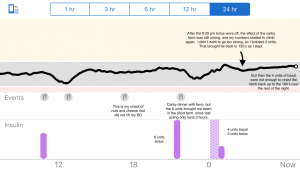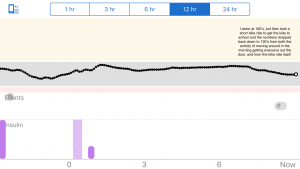I like the idea of adopting a vegetarian (vegan if possible) diet, but I am still struggling to see how I would do that without relying on lots of insulin. So many vegan dishes are heavy in carbs. Wednesday the 20th was a day to explore how I’m doing in general related to a vegan diet. I attended an event that served a vegan dinner. Prior to arriving, I snacked on nuts and cheese to make sure that I would not be too hungry. That didn’t lift my blood sugar materially. Then, as dinner was served, I bolused 6 units, which is how much I currently use if I’m expecting a carbo load in what I’m intending to eat. This brought my levels back down into the 120’s briefly, but as the bolus (fast-acting) insulin began to wear off, my levels climbed back up into the 170’s-180’s around the time I planned to go to sleep. I decided to inject another bit (2 units) of bolus (fast-acting) insulin to bring the levels down, and then went with four (4) units of basal insulin to carry my through the night. I didn’t want to inject too much insulin right before bed because then I might crash as I slept, which is always risky business.

The four (4) units were not enough to keep my levels even overnight. I crept back up, waking up around 170’s. If I had it to do over again, I would have used five (5) units of basal (long-acting) insulin.
I found interesting to be reminded that sleep is the state where sugars rise. Without eating anything, I finished the morning routine and then rode my bike to school with my son. By the time I finished the morning thrash and I returned from a short ride (5-10 minutes each way), my numbers had dropped back down into the 120’s.

The takeaway here is that how much carb load lingers in one’s system impacts how quickly the system can recover to healthy levels of blood sugar. By 9 am, I didn’t have much source of blood sugar remaining in my digestive track, so mild activity was sufficient to bring my levels back down.